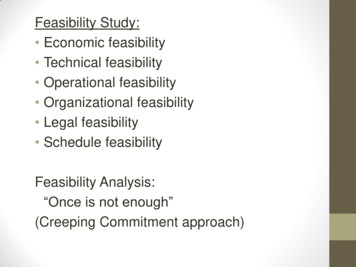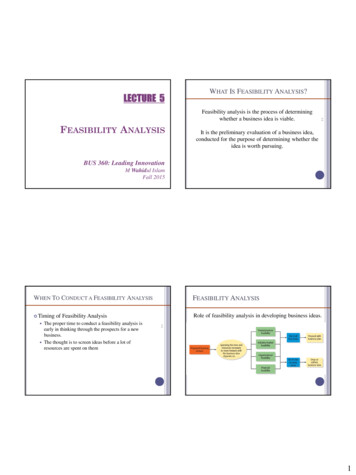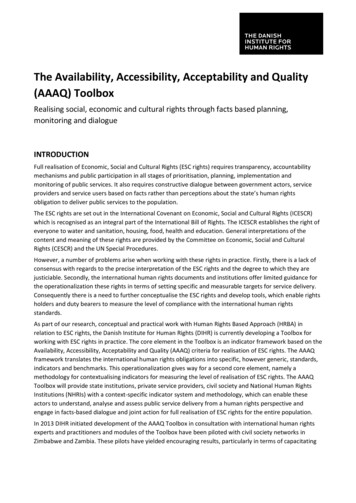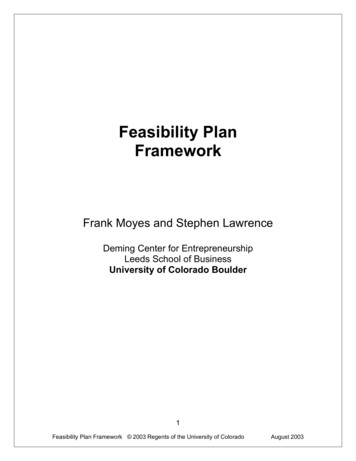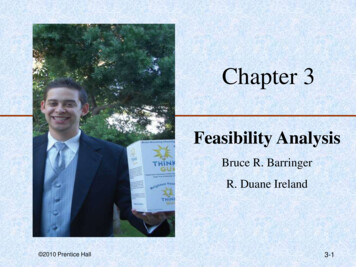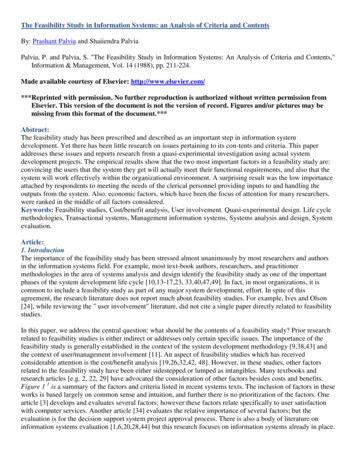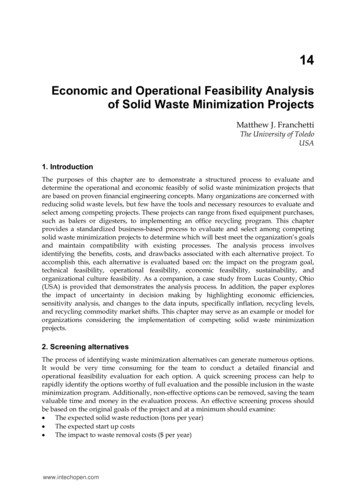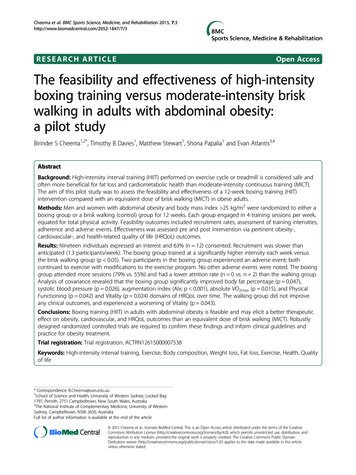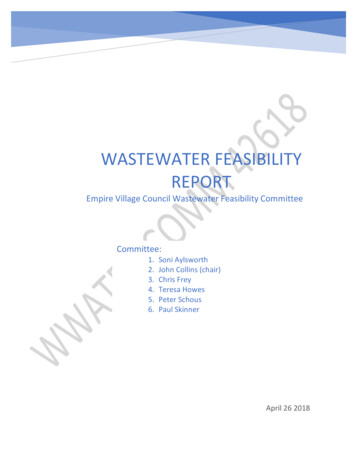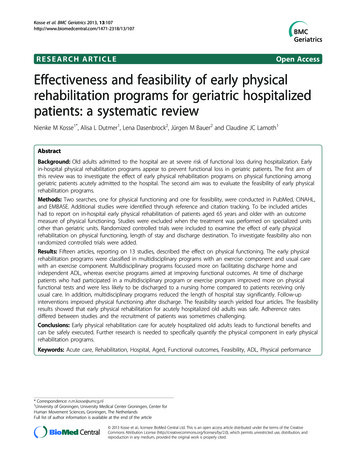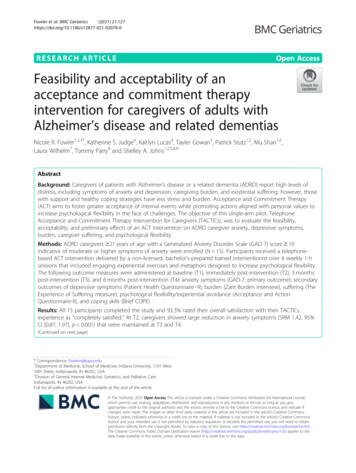
Transcription
Fowler et al. BMC Geriatrics(2021) SEARCH ARTICLEOpen AccessFeasibility and acceptability of anacceptance and commitment therapyintervention for caregivers of adults withAlzheimer’s disease and related dementiasNicole R. Fowler1,2,3*, Katherine S. Judge4, Kaitlyn Lucas4, Tayler Gowan5, Patrick Stutz1,2, Mu Shan1,6,Laura Wilhelm7, Tommy Parry8 and Shelley A. Johns1,2,5,8,9AbstractBackground: Caregivers of patients with Alzheimer’s disease or a related dementia (ADRD) report high levels ofdistress, including symptoms of anxiety and depression, caregiving burden, and existential suffering; however, thosewith support and healthy coping strategies have less stress and burden. Acceptance and Commitment Therapy(ACT) aims to foster greater acceptance of internal events while promoting actions aligned with personal values toincrease psychological flexibility in the face of challenges. The objective of this single-arm pilot, TelephoneAcceptance and Commitment Therapy Intervention for Caregivers (TACTICs), was to evaluate the feasibility,acceptability, and preliminary effects of an ACT intervention on ADRD caregiver anxiety, depressive symptoms,burden, caregiver suffering, and psychological flexibility.Methods: ADRD caregivers 21 years of age with a Generalized Anxiety Disorder Scale (GAD-7) score 10indicative of moderate or higher symptoms of anxiety were enrolled (N 15). Participants received a telephonebased ACT intervention delivered by a non-licensed, bachelor’s-prepared trained interventionist over 6 weekly 1-hsessions that included engaging experiential exercises and metaphors designed to increase psychological flexibility.The following outcome measures were administered at baseline (T1), immediately post-intervention (T2), 3 monthspost-intervention (T3), and 6 months post-intervention (T4): anxiety symptoms (GAD-7; primary outcome); secondaryoutcomes of depressive symptoms (Patient Health Questionnaire–9), burden (Zarit Burden Interview), suffering (TheExperience of Suffering measure), psychological flexibility/experiential avoidance (Acceptance and ActionQuestionnaire-II), and coping skills (Brief COPE).Results: All 15 participants completed the study and 93.3% rated their overall satisfaction with their TACTICsexperience as “completely satisfied.” At T2, caregivers showed large reduction in anxiety symptoms (SRM 1.42, 95%CI [0.87, 1.97], p 0.001) that were maintained at T3 and T4.(Continued on next page)* Correspondence: fowlern@iupui.edu1Department of Medicine, School of Medicine, Indiana University, 1101 West10th Street, Indianapolis, IN 46202, USA2Division of General Internal Medicine, Geriatrics, and Palliative Care,Indianapolis, IN 46202, USAFull list of author information is available at the end of the article The Author(s). 2021 Open Access This article is licensed under a Creative Commons Attribution 4.0 International License,which permits use, sharing, adaptation, distribution and reproduction in any medium or format, as long as you giveappropriate credit to the original author(s) and the source, provide a link to the Creative Commons licence, and indicate ifchanges were made. The images or other third party material in this article are included in the article's Creative Commonslicence, unless indicated otherwise in a credit line to the material. If material is not included in the article's Creative Commonslicence and your intended use is not permitted by statutory regulation or exceeds the permitted use, you will need to obtainpermission directly from the copyright holder. To view a copy of this licence, visit http://creativecommons.org/licenses/by/4.0/.The Creative Commons Public Domain Dedication waiver ) applies to thedata made available in this article, unless otherwise stated in a credit line to the data.
Fowler et al. BMC Geriatrics(2021) 21:127Page 2 of 10(Continued from previous page)At T4, psychological suffering (SRM 0.99, 95% CI [0.41, 1.56], p 0.0027) and caregiver burden (SRM 0.79, 95% CI[0.21, 1.37], p 0.0113) also decreased.Conclusions: Despite a small sample size, the 6-session manualized TACTICs program was effective in reducinganxiety, suggesting that non-clinically trained staff may be able to provide an effective therapeutic intervention byphone to maximize intervention scalability and reach.Trial registration: Institutional Review Board (IRB) protocol #1904631305 version 05-14-2019. Recruitment began06-14-2019 and was concluded on 12-09-2019.Recruitment began 06-14-2019 and was concluded on 12-09-2019.Keywords: Alzheimer’s disease, Anxiety; dementia, Caregiver, Acceptance and commitment therapyBackgroundOf the more than 5 million people in the U.S. with Alzheimer’s disease or a related dementia (ADRD) [1], 75% arecared for by family caregivers [2]. Currently 16 millionpeople in the U.S. are providing care to a family member orfriend with ADRD [3, 4]. ADRD caregivers report higher distress, including symptoms of anxiety and depression [5–9],caregiving burden [10], and existential suffering [11], thancaregivers of people with other chronic diseases, such asheart failure or cancer. Alarmingly, 60% of ADRD caregiverswithout an anxiety or depression diagnosis at the beginningof the caregiving journey develop one or both diagnoseswithin two years of caregiving [8]. This psychological morbidity is strongly associated with caregivers’ coping strategies[12, 13], such that support and healthy coping strategies areassociated with less stress and burden [14–16].Multi-component psychotherapeutic interventions, suchas cognitive-behavioral therapy (CBT), have proven moderately effective in targeting caregiver distress and adaptivecoping [17, 18]. Meta-analyses reveal that CBT reducesADRD caregiver depressive symptoms; however, it is lesseffective for ADRD caregiver anxiety [17, 19, 20]. Thismay be due to misalignment between CBT goals andADRD caregivers’ experiences. Specifically, CBT aims tochallenge and modify dysfunctional thoughts viewed asantecedents of distress while increasing pleasant activities.For ADRD caregivers, the unchangeable nature of theirsituation and lack of control over their loved one’s cognitive decline or behaviors may make this impossible. Additionally, access to therapeutic interventions that arecommonly delivered in-person is frequently cited as alimitation in ADRD caregiver interventions [17].A different approach to supporting ADRD caregivers,acceptance-based coping, has been associated withreduced anxiety and depression for caregivers [21], suggesting that interventions focused on acceptance mayprovide a promising alternative for ADRD caregivers. Anovel behavioral therapy, Acceptance and CommitmentTherapy (ACT), offers therapeutic tools aimed at fostering greater acceptance of internal events (e.g., thoughts,feelings) while promoting actions aligned with personalvalues (e.g., being compassionate) to increase psychological flexibility in the face of challenges (e.g., carerecipients’ progressive decline) [22, 23]. These tools maybe useful to ADRD caregivers given the incurability ofADRD and the demands of caring for these individuals.ACT has proven beneficial for caregivers of childrenwith autism [24] and life-threatening illnesses [25] andhas been used to treat people with chronic pain [26] andanxiety [27]. Two European studies have investigated inperson ACT interventions for ADRD caregivers andfound improved symptoms of anxiety and depression;however, perceived burden, suffering, and psychologicalflexibility were not measured [28, 29]. Additionally,research with US caregivers has yet to examine the feasibility and acceptability of implementing ACT withADRD caregivers that is delivered via telephone.The objective of this single-arm pilot was to evaluate thefeasibility, acceptability, and preliminary effects of an ACTintervention on ADRD caregiver anxiety, depressive symptoms, burden, caregiver suffering, and psychological flexibility. For this study we define caregiver suffering as holisticconstruct that includes psychological distress, physicalsymptoms, and existential or spiritual suffering [11] andpsychological flexibility as a measure of how caregivers relate to their thoughts and feelings. The Telephone Acceptance and Commitment Therapy Intervention forCaregivers (TACTICs) is a telephone- based behavioralintervention designed to increase caregivers’ capacity toconnect with the present moment, accept difficult emotions, let go of unhelpful thoughts, take perspective, clarifyvalues, and engage in meaningful action while navigatingthe challenges of caring for a family member with ADRD.To maximize the accessibility and scalability, clinical dissemination, and implementation potential of TACTICs, thisstudy employed a non-licensed, bachelor’s-level interventionist to deliver the 6-week intervention via telephone.MethodsStudy designThe study was approved by the Indiana .
Fowler et al. BMC Geriatrics(2021) 21:127Informed consent was obtained via phone from eachparticipant upon enrollment and prior to any datacollection.The primary goal of this single arm pilot was to assessintervention feasibility and acceptability. We alsoassessed the impact of TACTICs on ADRD caregiveranxiety, depression, burden, suffering, psychologicalflexibility, and coping.ParticipantsTACTICs was designed for caregivers of older adultswith ADRD; thus, persons with ADRD were notenrolled. Caregivers were included if they were 21 yearsof age, the primary caregiver for a family member withADRD, able to provide informed consent, intended tocontinue caregiving for 12 months, able to communicate in English, willing to attend six weekly 1-h TACTICs sessions on the phone, and had a Generalized Anxiety Disorder Scale (GAD-7) score 10 indicating moderate or higher symptoms of anxiety [30, 31]. Caregiverswere excluded if they self-reported that they were a nonfamily member, had a diagnosis of ADRD, or had a serious mental illness (e.g., bipolar or schizophrenia).Additionally, caregivers were not enrolled if their familymember was living in long-term, supportive housingsuch as assisted living, personal care, or a nursing home.Caregivers were recruited from Indiana, USA from primary care clinics and the Aging Brain Care Program atEskenazi Health; and primary care, geriatric psychiatry,and neurology clinics affiliated with Indiana UniversityHealth. Additionally, we recruited through communitysites such as local organizations that sponsor supportgroups and other services for people with ADRD.Intervention and proceduresThis pilot used a single arm design. Eligible caregiverswere identified by active patient lists for participatingclinics that were IRB approved recruitment sites. Caregivers (or emergency contacts or health care power ofattorneys listed in patients’ electronic health records)were mailed an introductory letter about the TACTICsproject. Potential participants who did not respondwithin 7–10 days after receiving the letter were contacted by a trained research assistant who presentedmore detailed information about the study and inquiredabout interest in participating. If the caregiver was interested, the research assistant administered an eligibilityscreener, which included the GAD-7. If caregiversmet all eligibility criteria, they were again asked aboutinterest. If they agreed to participate, the informed consent process, which included an assessment of decisionalcapacity with study-specific teach back questions to provide consent, was administered via telephone. Followingthe informed consent, the baseline assessment wasPage 3 of 10completed, and all enrolled caregivers received papercopies of the Informed Consent form and a 20 gift cardfor completing the baseline assessment. The first TACTICs session was scheduled 1–3 weeks following the baseline assessment.TACTICs is an ACT telephone-based interventiondelivered to ADRD caregivers by a non-licensed, bachelor’s-prepared trained interventionist. As an ACT intervention, TACTICs is a mindfulness-based behavioraltherapy that incudes the main processes of ACT; developing acceptance of unwanted private experiences whichare out of persons control and recognizing a person’scommitment and action toward living a valued life.ACT interventions have been shown to be effectivewith a diverse range of clinical conditions [32]. The goalof the program is to enhance psychological flexibilitythrough practice of six core skills—acceptance, cognitivedefusion, mindful awareness of the present moment,self-as-context (perspective taking), values clarification,and committed action. Psychological flexibility focuseson connecting with the present moment rather thanavoiding unwanted internal experiences and engaging inbehavior aligned with one’s values [33, 34]. Notably,psychological flexibility is theoretically linked toimprovements in anxiety [27], depressive symptoms [35],and wellbeing [35]. Prior to the first session, caregiversreceived a TACTICs binder for use during sessions thatincluded reading materials, worksheets, and handoutssummarizing session topics. The 6-week interventionconsisted of 1-h telephone sessions that includedengaging experiential exercises and metaphors designedto increase psychological flexibility through practice ofone or more of the six skills in each session (see Table 1for session descriptions). The interventionist guidedcaregivers in brief mindfulness meditation practices thatencouraged non-judgmental awareness of thoughts, feelings, and bodily sensations in the present moment ineach session. To strengthen psychological flexibility, participants were invited to practice mindfulness at homein between sessions using 10-min audio recordings available via a computer download or compact disc, according to each participant’s preference. Caregivers alsoidentified deeply-held values to serve as a guide whenchoosing how to spend limited time or energy and setvalues-based action goals each week.The bachelor’s-level interventionist (TMG) has a fouryear degree in Psychology but is not a licensed therapistor psychologist. She was trained by a doctoral level clinical health psychologist (SAJ) using didactics, readings,live demonstrations, and role-plays. The interventionistalso received supervision throughout the study from amaster’s level clinician (TDP) with ACT training. A totalof 23 (25.6%) of the audio-recorded TACTICs sessionswere assessed for fidelity to the intervention manual
Fowler et al. BMC Geriatrics(2021) 21:127Page 4 of 10Table 1 TACTICs Intervention SessionsSession Theme, Mindfulness Practice, and Home Practice1Fostering Contact with the Present-Moment: Cultivate present-moment awareness; explore caregiving stressors and usual responses; seeopportunities for wise actionMindfulness: Body ScanHome practice: Body Scan daily; eat one meal mindfully; mindfulness of one daily activity2Values and Meaningful Connections: Value-based living; mindful acceptance to promote values-consistent behaviorMindfulness: Abbreviated Body Scan with Awareness of Breath; Watching the SkyHome practice: Choice of daily mindfulness practice; values-based action worksheet3Being Here for the Life You Have: Knowing Self as Context: Observe inner experiences without getting “hooked” to lessen suffering andlive with purposeMindfulness: Body Scan; Leaves on a StreamHome practice: Body Scan daily; Passengers on a Bus worksheet; Caregiver thinking diary4Making Wise Choices: Acceptance & Defusion: Differentiate having a thought from buying a thought; acceptance/willingness differs fromcontrol/avoidanceMindfulness: Awareness of Breath; 3-Step Compassion practiceHome practice: Alternate Body Scan and 3-Step Compassion practice daily5Embracing the Present Moment and Choosing Values-Based Action on the Path to Vital Living: Notice how body and mind feel atpleasant and unpleasant times; use values as a guide for meaningful livingMindfulness: Body Scan with “It’s like this yes”; Welcome Anxiety My Old FriendHome practice: Choice of daily mindfulness practice; Values Form; Embracing the Unwanted6Committed Action and Existential Well-Being: Differences between pre-study anxiety coping vs. newer options; reinforce action plansMindfulness: Minimally-guided Sitting Meditation; Lovingkindness MeditationHome practice: Reinforce possibilities to support continued practice of skills; resource flierusing a structured fidelity checklist similar to the oneused in our previous ACT interventions [36]. The average fidelity rating across all sessions rated was 98.6%(SD 0.03), suggesting the interventionist deliveredTACTICs in a manner that was highly adherent to theintervention manual.Data collection and measuresAll data were collected from caregivers via phone bya trained research assistant and entered online into asecure REDCap (Research Electronic Data Capture)database.To assess preliminary efficacy of the intervention, psychometrically validated outcome measures were administered at baseline (T1), immediately post-intervention(T2), 3 months post-intervention (T3), and 6 monthspost-intervention (T4). At baseline (T1), social anddemographic data were also collected, including age, sex,race, ethnicity, relationship to the ADRD patient, frequency of contact with the patient, geographic distancefrom the patient, caregiver education level, and annualincome. Severity of cognitive impairment for each participant’s care recipient was also assessed at T1 using theDementia Severity Rating Scale (DSRS) [37]. Feasibilitywas measured by calculating the enrollment, completionof intervention, attrition, and completion rates of outcome assessments through T4. Acceptability was measured by caregiver responses to a 7-item TACTICssurvey that assessed satisfaction with TACTICs at T2.The Generalized Anxiety Disorder Scale (GAD-7) [30, 31]consists of 7 items that assessed anxiety symptoms (primaryoutcome) at each time point [30, 31, 38]. Depressivesymptoms were measured with the Patient Health Questionnaire–9 (PHQ-9) that consists of 9 items that assess somaticand non-somatic symptoms of depression [39, 40]. Caregiverburden was measured with the Zarit Burden Interview (ZBI),which includes 22 items that measure the objective and subjective burden experienced by family caregivers [38, 41, 42].Caregiver suffering was assessed with The Experience of Suffering measure that contains 33 items across three subscales:physical (9 items), psychological (15 items), and existential (9items) suffering [11]. Psychological flexibility and its opposite,experiential avoidance, were measured at each time pointwith the 7-item Acceptance and Action Questionnaire-II(AAQ-II) [43]. Coping skills and styles of caregivers weremeasured with the Brief COPE, a 28-item measure of 14coping strategies used in response to stressors [44]. All measures have been statistically validated and have demonstratedgood internal consistency in prior trials [31, 42].Data analysisDescriptive statistics for caregivers’ social and demographic characteristics were summarized as frequencyand percent for categorical variables, as mean and standard deviation for normal continuous variables, includingtheir relationship to the person with ADRD and theseverity of the care recipients’ ADRD, were calculated.TACTICs feasibility measures included at least 50% ofeligible caregivers enrolling in the study and attendancerates of 70% or greater across the six TACTICs sessions.Acceptability was assessed to be that at least 70% ofcaregivers enrolled in the study completed the studythrough T4 and at least 70% of enrolled caregivers
Fowler et al. BMC Geriatrics(2021) 21:127reported being mostly to completely satisfied with theirexperience in TACTICs [45].The standardized response mean (SRM) effect size forthe outcomes was calculated to assess the magnitude ofintervention effects at T2, T3, and T4. To determineSRM, mean change in T2, T3, and T4 scores relative tobaseline (T1) was calculated and divided by the standarddeviation (SD) of change. The 95% confidence intervals(CIs) were computed for each caregiver (caregiver’smean change divided by the sample’s SD of changescores). The SAS MEANS procedure with the LCLMand UCLM options were used to compute the lower andupper 95% confidence limits for the SRM statistic. Theprimary efficacy-related goal of this pilot was to estimateeffect sizes, and the 2-sided paired t test was used todetermine significant (P 0.05) responsiveness over time.Due to the small sample, marginal significance (0.05 P 0.10) is also reported. Standardized response meansof 0.2, 0.5, and 0.8 indicated small, medium, and largeeffect sizes, respectively [46]. Analyses were performedusing SAS version 9.4 (SAS Institute, Inc., Cary, NC).Page 5 of 10Table 2 Caregiver Social and Demographic CharacteristicsVariableCaregivers n 15Completed all 6 TACTICs sessions, n (%)15 (100)Age in years, mean (SD)68.85 (11.70)Sex, n (%)Female12 (80)Ethnicity and race, n (%)Non-Hispanic White15 (100)Education, n (%)Not a college graduate6 (40)College graduate9 (60)Self-reported income situation, n (%)Do not have enough to make ends meet1 (6.7)Have just enough to make ends meet4 (26.7)Comfortable10 (66.6)Recruitment location, n (%)Clinical sites3 (20)Community sites12 (80)Caregiver relationship to ADRD patient, n (%)ResultsSpouseSocial and demographic characteristicsAdult child or child-in-law3 (20)Sibling1 (6.67)Social and demographic characteristics of the 15 caregivers who completed TACTICs are shown in Table 2.On average, caregivers were 68 years old, and most(73%) were caregiving for their spouse with ADRD; 80%were female, and all reported their race as non-Hispanicand white. The majority (93%) were caring for an individual with mild to moderate ADRD and reported theirown health status as good (53%), very good (40%) orexcellent (6.7%). At baseline, 87% had mild or moderatedepressive symptoms and all (100%) had high levels ofcaregiver burden as measured by the Zarit Burden Index.Given that clinically significant anxiety was required foreligibility, 73% had moderate anxiety and 27% had severeanxiety at baseline. Two caregivers had their familymember move into long-term care during their participation in TACTICs. Given that this was a pilot and thatfamily caregivers continue to provide care and supportwhen their family member moves into long-term care,the remained in the study [47].Feasibility and acceptabilityOver 25 weeks, 48 caregivers were approached. Seven(14.5%) caregivers refused to be screened for eligibilitywhile 41 (85.4%) agreed (see Fig. 1). Of the 41 caregiversscreened for eligibility, 16 (39%) were eligible and all 16(100%) enrolled in the study. Twenty-five (61%) caregivers were ineligible, with GAD-7 scores 10 representing the primary reason for ineligibility.Retention across the study timeframe was high. Onecaregiver withdrew between consent and T1 (prior to11 (73.3)Severity of ADRD of caregiver’s care recipient, n (%)Mild4 (26.7)Moderate10 (66.6)Severe1 (6.7)Participate in caregiver support group during TACTICsYes4 (26.7)Participate in individual therapy or counseling during TACTICsYes2 (13.3)Caregiver self-reported health status, n (%)Excellent1 (6.7)Very good6 (40)Good8 (53.3)beginning TACTICs) and one caregiver withdrewbetween T2 and T3, resulting in an overall retention rateof 87.5% at T4. With respect to adherence to the TACTICs protocol, 100% of caregivers who began TACTICs(n 15) completed all six sessions.To determine program acceptability, participants ratedsix questions about their satisfaction with TACTICs.Using a 5-point Likert scale with “1” being “extremelyunsatisfied” and “5” being “extremely satisfied,” participants were asked to rate their satisfaction with TACTICs. One hundred percent of participants rated theiroverall satisfaction with their TACTICs experience as a9 or 10 on a 10-point scale (Table 3).
Fowler et al. BMC Geriatrics(2021) 21:127Page 6 of 10Fig. 1 Consolidated Standards of Reporting Trials (CONSORT) flowchart, including number of participants assessed at each time pointIntervention effectsTable 4 shows preliminary intervention effects for caregivers. At T2, caregivers showed a significantly large reduction in anxiety symptoms (SRM 1.42, 95% CI [0.87,1.97], p 0.001) and a medium reduction in caregiverphysical suffering that approached statistical significance(SRM 0.50, 95% CI [0.05, 1.05], p 0.07).At T3 and T4, effects were strengthened for anxietysymptoms. Caregivers showed large, statistically significant improvements in GAD-7 scores at T3 (SRM 1.28,95% CI [0.71, 1.86], p 0.0003) and T4 (SRM 1.94, 95%CI [1.36, 2.51], p 0.0001). At T4, statistically significantTable 3 Caregiver Satisfaction with TACTICsdecreases in caregiver psychological suffering (SRM 0.99,95% CI [0.41, 1.56], p 0.0027) and caregiver burden(SRM 0.79, 95% CI [0.21, 1.37], p 0.0113) wereobserved.Although they did not reach statistical significance, thetrends for the outcomes of physical suffering and the coping subscales of self-distraction and denial are importantto consider when thinking about future research studieswith larger samples. Specifically, physical suffering showeda decrease between T1 and T2 (SRM 0.50, 95% CI (0.05,1.05) p .073); self-distraction showed a decline betweenT1 and T3 (SRM 0.54, 95% CI ( 0.04, 1.12) p .06); andaSurvey ItemCaregivers (n 15)MeanSDOverall, how satisfied are you with your experience in the TACTICs program?1 Not at allsatisfied10 CompletelySatisfied9.140.95How satisfied are you with the number of sessions?1 Extremelyunsatisfied5 ExtremelySatisfied4.500.854.430.76How satisfied are you with the length of the sessions?How satisfied are you with the topics of the sessions?How satisfied are you with the skill of the study therapist?4.790.434.790.43How satisfied are you with the reading materials and worksheets you received?4.500.65How satisfied are you with the mindfulness recordings you received?4.570.65aAll items were asked at T2
Fowler et al. BMC Geriatrics(2021) 21:127Page 7 of 10Table 4 Caregiver OutcomesT1 Mean(SD) n 15T2 Mean(SD) n 15T3 Mean(SD) n 14T4 Mean(SD) n 14T1 – T2PT1-T3 SRMSRM 95% CI value 95% CIPT1-T4 SRMvalue 95% CIPvalueAnxiety13.33 (2.79)8.00 (3.21)7.00 (3.78)6.07 (3.36)1.42 (0.87,1.97) 1.28 (0.71,0.0001 1.86)0.0003 1.94 (1.36,2.51) 0.0001Depressivesymptoms7.47 (3.20)5.80 (3.12)6.07 (4.03)5.57 (3.74)0.42 ( 0.14,0.97)0.1299 0.34 ( 0.24, 0.2277 0.44 ( 0.14, 0.12710.92)1.01)Caregiver Burden41.73 (11.63)39.13 (15.53)39.00 (12.44)34.50 (15.58)0.31 ( 0.24,0.86)0.2486 0.40 ( 0.17, 0.1542 0.79 (0.21,0.98)1.37)PsychologicalFlexibility18.53 (7.59)17.27 (8.04)18.29 (8.47)16.29 (8.25)0.24 ( 0.31,0.79)0.3677 0.10 ( 0.48, 0.7080 0.38 ( 0.20, 0.18000.68)0.96)Physical suffering7.13 (2.26)6.13 (3.11)6.64 (3.91)6.14 (3.46)0.50 ( 0.05,1.05)0.0733 0.11 ( 0.47, 0.6977 0.27 ( 0.31, 0.33900.68)0.84)Psychologicalsuffering14.07 (4.98)13.67 (6.03)13.29 (5.55)10.50 (4.11)0.11 ( 0.44,0.66)0.6786 0.13 ( 0.45, 0.6396 0.99 (0.41,0.71)1.56)Existentialsuffering15.00 (3.78)15.20 (3.55)15.93 (3.71)16.07 (3.89) 0.07 ( 0.63, 0.7828 0.480.0966 0.470.10070.48)( 1.06, 0.10)( 1.05, 0.11)Self-distraction5.93 (1.22)5.53 (1.36)5.21 (1.19)6.07 (1.54)0.38 ( 0.17,0.93)Denial2.00 (0)2.13 (0.35)2.21 (0.58)2.71 (1.27) 0.38 ( 0.93, 0.6164 0.37 ( 0.17)0.95, 0.21)Behavioraldisengagement2.47 (0.83)2.13 (0.35)2.36 (0.63)2.50 (1.02)Acceptancecoping6.60 (1.18)6.53 (1.81)7.00 (1.18)Active coping6.13 (1.46)6.00 (1.36)6.43 (1.74)OutcomesDistress0.0113Caregiver suffering0.0027Coping0.1643 0.54 ( 0.04, 0.0650 0.08 ( 1.12)0.66, 0.50)0.77010.1894 0.56 ( 1.14, 0.01)0.05480.41 ( 0.15,0.96)0.1362 0.10 ( 0.48, 0.7207 0.07 ( 0.68)0.64, 0.51)0.80696.50 (1.56)0.05 ( 0.50,0.60)0.8494 0.38 ( 0.96, 0.19)0.1739 0.08 ( 0.50, 0.76460.66)6.21 (1.42)0.10 ( 0.46,0.65)0.7090 0.27 ( 0.84, 0.31)0.3356 0.15 ( 0.73, 0.43)0.5830Abbreviations: CI confidence interval, SD standard deviation, SRM standardized response mean, T1 baseline, T2 immediately post-intervention, T3 3 months postintervention, T4 6 months post-interventiondenial showed an improvement between T1 and T4 (SRM-0.56, 95% CI ( 1.14, 0.01) p .054).DiscussionThis pilot of TACTICs, an ACT-derived intervention forADRD caregivers with clinically significant anxiety, hasseveral important findings. First, a 6-week ACT intervention delivered remotely, via telephone, is feasible andhighly acceptable among ADRD caregivers. Second, anACT intervention for this population can be successfullytailored to individual caregivers’ experience and be delivered by bachelor’s-level, non-licensed personnel withhigh fidelity. Third, preliminary effects suggest thatTACTICs may significantly reduce moderate-to-severeanxiety, a common and disruptive symptom amongADRD caregivers [31]. Lastly, these large, statisticallysignificant, and clinically meaningful reductions in anxiety symptoms were demonstrated at each follow-up andsustained at 6 months post-intervention [48, 49]. Despitethe small sample size and limited power, efficacy testsgenerally showed statistically significant results foranxiety and marginally significant effect sizes for caregiver burden.Possibly the most important finding from this pilotwas the willingness of ADRD caregivers to participate inTACTICs with high adherence and satisfaction. Amongthe 15 caregivers who enrolled and completed the baseline assessment, 100% competed all six sessions, demonstrating an extremely high level of protocol adherenceand acceptability. This includes two caregivers whoexperienced their family member with ADRD movinginto long-term care during their time in the TACTICsproject. Additionally, 100% of caregivers rated satisfaction with the TACTICs program as 9 on a 1 to 10point scale, and 100% endorsed that the TACTICs program “quite a bit” or “very much” helped them c
acceptance-based coping, has been associated with reduced anxiety and depression for caregivers [21], sug-gesting that interventions focused on acceptance may provide a promising alternative for ADRD caregivers. A novel behavioral therapy, Acceptance and Commitment Therapy (ACT), offers therapeutic tools aimed at foster-
